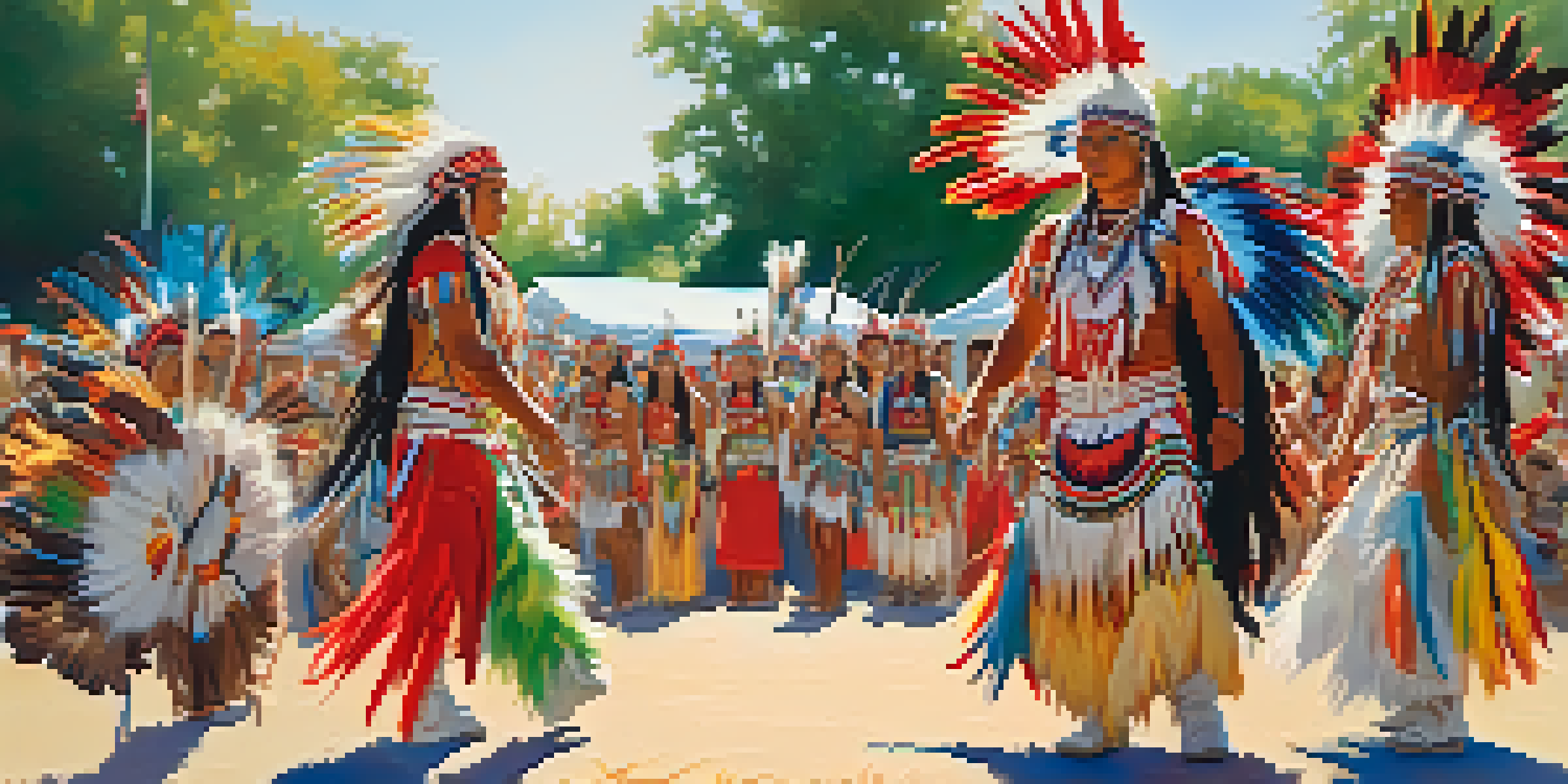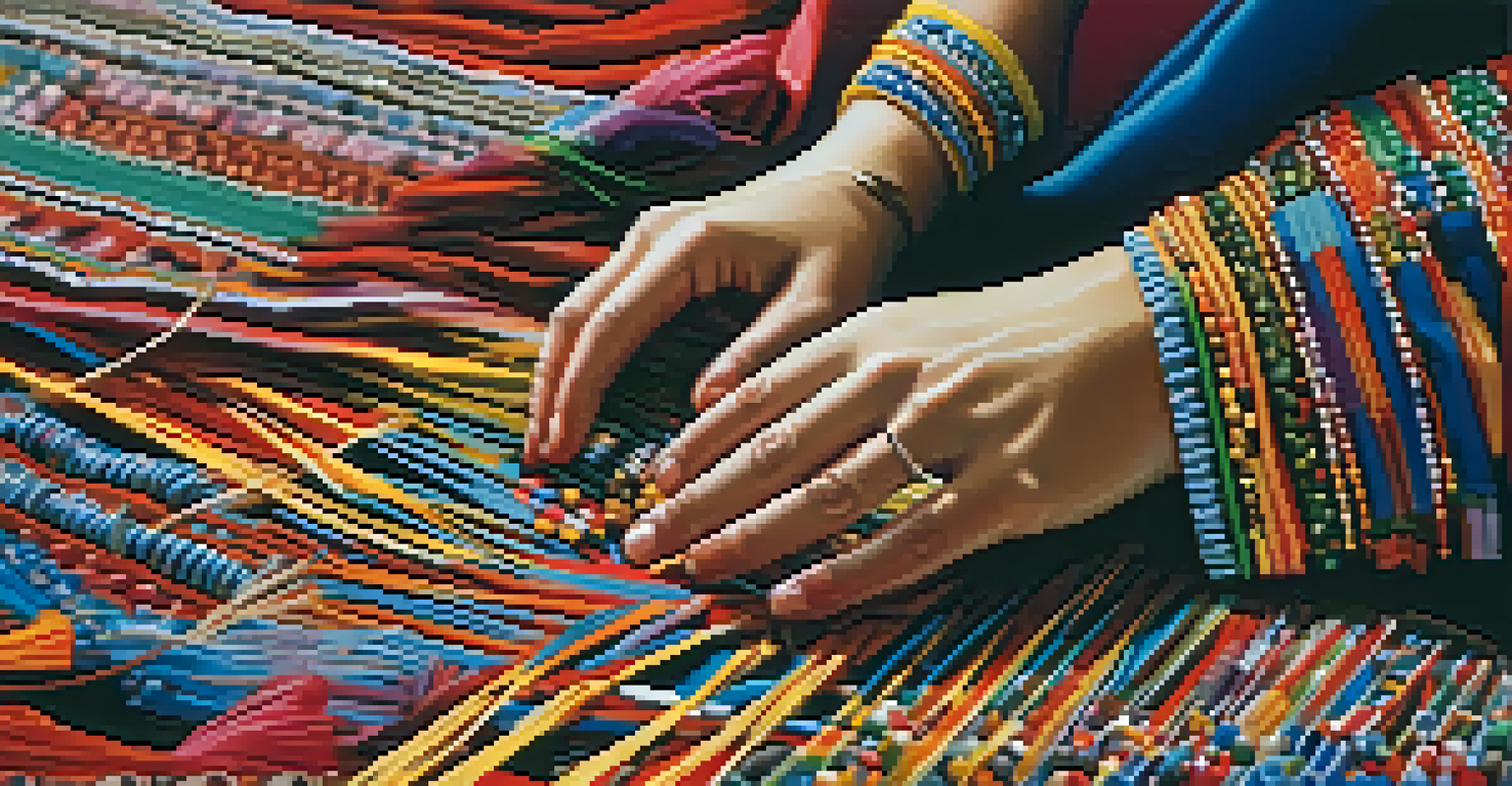Globalization's Effect on Indigenous Dance Traditions

Understanding Indigenous Dance Traditions
Indigenous dance traditions are rich cultural expressions that encapsulate the history, beliefs, and values of a community. These dances often serve as a means of storytelling, preserving the heritage and identity of indigenous peoples. From the vibrant powwows of Native American cultures to the intricate dances of Aboriginal Australians, these performances are deeply rooted in tradition and spirituality.
Dance is the hidden language of the soul.
Typically passed down through generations, these dances are not just art forms but vital elements of social cohesion and cultural identity. They often coincide with significant life events, such as weddings, harvests, and rites of passage, reinforcing community bonds. Understanding these traditions provides insight into the unique worldviews and practices of indigenous peoples.
However, as globalization spreads, these traditions face both challenges and opportunities, prompting a significant examination of their future. The intersection of global influences with local customs often raises questions about authenticity and preservation. As we delve deeper, we'll explore how globalization reshapes these dance traditions.
The Impact of Globalization on Traditional Practices
Globalization introduces new cultural exchanges that can enrich indigenous dance traditions but also risk diluting their authenticity. As traditional practices come into contact with global trends, they may adapt or transform in response to external influences. This adaptability can lead to innovative forms of expression that resonate with younger generations, but it may also lead to the loss of traditional elements.

For example, the incorporation of modern music and dance styles into traditional performances can attract wider audiences, yet it may alienate purists who seek to preserve the original forms. This tension between innovation and preservation prompts crucial discussions about what it means to maintain cultural integrity in a rapidly changing world.
Globalization's Dual Impact
Globalization introduces both challenges and opportunities for indigenous dance traditions, prompting communities to adapt while striving to maintain authenticity.
While some argue that globalization fosters a blending of cultures, others caution that it can lead to cultural appropriation, where elements of indigenous dance are commodified without proper acknowledgment. This dynamic highlights the delicate balance that communities must navigate in preserving their identities amidst global influences.
Cultural Appropriation and Its Consequences
Cultural appropriation is a significant concern for many indigenous communities, especially when elements of their dance traditions are adopted by outsiders without permission or understanding. This practice often strips away the original context and meaning, reducing vibrant cultural expressions to mere entertainment. Such acts can perpetuate stereotypes and undermine the significance of these traditions.
Cultural diversity is like a symphony; it takes many instruments to create a beautiful piece of music.
For instance, when indigenous dance is performed in commercial settings, it may be stripped of its ceremonial significance, transforming it into a spectacle. This shift not only disrespects the culture but also risks erasing its historical narratives and spiritual connections. Communities often view these appropriations as a form of exploitation, leading to calls for greater respect and understanding.
Addressing cultural appropriation requires awareness and education, encouraging respectful engagement with indigenous cultures. By fostering dialogues about the importance of context and consent, a more equitable appreciation of these traditions can emerge. This conversation is vital in ensuring that indigenous voices are heard and respected in the global arena.
Preservation Efforts Amid Global Change
Despite the challenges posed by globalization, many indigenous communities are actively working to preserve their dance traditions. Efforts may include cultural festivals, workshops, and educational programs that promote awareness and appreciation of their heritage. These initiatives play a crucial role in teaching younger generations about the significance of their cultural practices.
Communities are also leveraging technology to document and share their dance traditions globally. Online platforms can showcase performances, history, and educational content, allowing for greater visibility and support. This digital presence helps foster connections with broader audiences while reinforcing a sense of pride and identity within the community.
Cultural Appropriation Concerns
Cultural appropriation poses significant risks to indigenous dance by commodifying these traditions and stripping them of their original meanings.
Moreover, partnerships with cultural organizations and allies can amplify these preservation efforts, ensuring that indigenous voices remain central in discussions about their traditions. By embracing both tradition and innovation, communities can navigate the complexities of globalization while safeguarding their rich cultural heritage.
The Role of Education in Cultural Awareness
Education plays a pivotal role in fostering cultural awareness and appreciation for indigenous dance traditions. By incorporating indigenous perspectives into educational curricula, schools can help students understand the significance and context of these art forms. Such education not only benefits students but also promotes respect for diverse cultures within society.
Workshops and community programs that teach indigenous dance can serve as a bridge between cultures, allowing participants to engage directly with the traditions. These experiences can cultivate empathy and understanding, encouraging a deeper appreciation for the complexities of cultural identity. Learning about the history and significance of indigenous dances fosters a connection that transcends mere observation.
As students and community members gain insight into the stories and meanings behind the dances, they become advocates for the preservation of these traditions. This ripple effect can lead to a broader societal shift, where respect for indigenous cultures becomes a shared value, enriching the cultural fabric of our communities.
The Future of Indigenous Dance in a Globalized World
The future of indigenous dance traditions in a globalized world remains a complex and evolving narrative. As communities adapt to changing circumstances, they face the dual challenge of preserving their heritage while also engaging with contemporary influences. This dynamic can lead to exciting new forms of expression that honor tradition while embracing innovation.
However, navigating this terrain requires careful consideration of identity and authenticity. Communities must find ways to celebrate their cultural uniqueness while being open to the influences that globalization brings. The ability to adapt, without losing sight of core values and meanings, will be essential in shaping the future of these dance traditions.
Preservation Through Education
Education plays a crucial role in fostering cultural awareness and respect for indigenous dance traditions, helping to ensure their appreciation and preservation.
Ultimately, the ongoing dialogue about globalization's impact on indigenous dance is vital for ensuring that these rich cultural expressions continue to thrive. By fostering collaboration, respect, and education, we can help create a world where indigenous dance traditions not only survive but flourish, contributing to the vibrant tapestry of global culture.
Conclusion: Embracing Change While Preserving Tradition
In conclusion, the interplay between globalization and indigenous dance traditions is a complex journey of adaptation and preservation. While globalization presents challenges, it also offers opportunities for growth and connection. Striking a balance between embracing change and honoring tradition is crucial for the sustainability of these cultural expressions.
Communities must continue to advocate for their rights and engage in conversations about cultural appropriation and respect. By educating others about the significance of their dance traditions, they can help foster a greater understanding and appreciation of their heritage. This approach not only empowers indigenous peoples but also enriches the cultural landscape for everyone.

As we move forward in an increasingly interconnected world, it is essential to celebrate and support the diversity of indigenous dance traditions. By doing so, we honor the stories, struggles, and triumphs of these cultures, ensuring that they remain vibrant and relevant for generations to come.